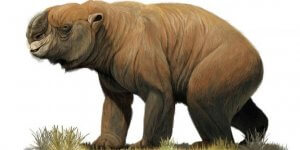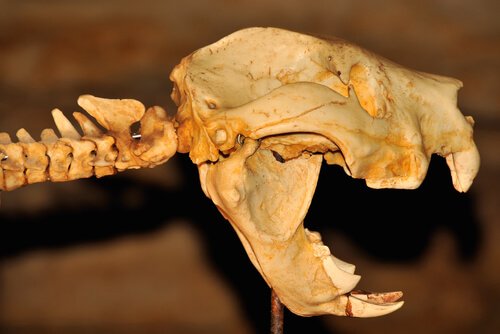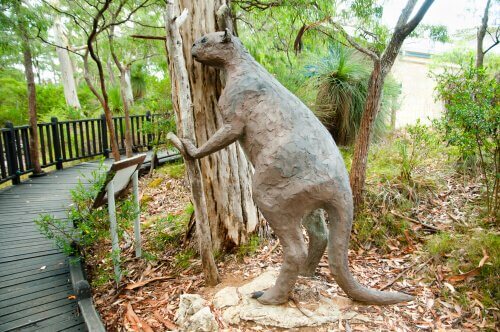The Extinct Megafauna of Australia


Written and verified by the biotechnologist Alejandro Rodríguez
In 1969, Rod Wells, a fossil-searching fanatic, entered Victoria Cave in southern Australia. He could never have imagined that deep inside lay fossils of some of the largest animals to roam the earth. Welcome to the megafauna of Australia.
This article will show you some of the most fascinating, enormous animals that lived in Australia during the Pleistocene era.
Megafauna of Australia: the Diprotodon
The diprotodon, shown in the photo at the top of this article, is the most gigantic marsupial to have ever lived, as far as we know. It was a herbivore with the approximate size of a rhinoceros.
Larger specimens could measure about three meters high, and weigh approximately three tons. Its closest living relatives are koalas and wombats.
According to scientists, these animals populated the island of Australia 1.6 million years ago. They seem to have lived in herds, and used to inhabit wooded areas and pastures, always near lakes or rivers. There they fed on leaves, grass, and some shrubs.
However, its large size and lack of agility played against it. This made it easy prey to another member of the megafauna of Australia– none other than the marsupial lion.
The marsupial lion, a natural hunter
This ruthless predator weighed between 220 and 350 pounds, and was the size of a leopard. No doubt this made him the largest carnivorous mammal in the area.

The Marsupial lion (Thylacoleo carnifex) was able to stalk and kill animals much larger than itself. Its strong, sharp claws helped it keep its prey captive.
One strange fact about this member of the megafauna of Australia is its origin. The marsupial lion’s ancestors were herbivores. Therefore, its teeth were adapted for that purpose. To solve this problem, the marsupial lion made up for the absence of canine teeth with its sharp incisors.
In addition, it developed knife-shaped premolars. These, along with the biting power of their jaws, had a devastating effect. For example, researchers believe that all these fearsome tools allowed the marsupial lion to kill its prey in just one minute.
Procoptodon, the goliath kangaroo
Once again, here is one of the most impressive specimens of the megafauna. The short-faced giant kangaroo (Procoptodon goliah) was very similar physically to present-day kangaroos. However, its face was flatter and its eyes faced forward.

With a height of more than two meters, and weighing up to 500 pounds, these marsupials could reach the leaves of the trees and eat them. Their arms had long, claw like fingers that allowed them to reach the farthest branches.
Despite being very similar to current kangaroos, there is scientific evidence that these animals didn’t move by jumping. Their anatomy is similar to biped walkers, like humans.
They were one of the last members of the megafauna. They became extinct about 50,000 years ago.
Why did they become extinct?
Exactly what happened to the Australian megafauna remains unclear to this day. Many studies point to climate change as the main cause.
Researchers like Tim Flannery blame it on the arrival of man on the Australian continent 50,000 years ago. Hunting and deforestation might have contributed to their disappearance as well. Nevertheless, this theory is controversial.
Whatever the cause of their extinction, it’s clear that amazing animals existed millions of years ago. Thankfully, modern paleontology and research have prevented these creatures from being forgotten.
In 1969, Rod Wells, a fossil-searching fanatic, entered Victoria Cave in southern Australia. He could never have imagined that deep inside lay fossils of some of the largest animals to roam the earth. Welcome to the megafauna of Australia.
This article will show you some of the most fascinating, enormous animals that lived in Australia during the Pleistocene era.
Megafauna of Australia: the Diprotodon
The diprotodon, shown in the photo at the top of this article, is the most gigantic marsupial to have ever lived, as far as we know. It was a herbivore with the approximate size of a rhinoceros.
Larger specimens could measure about three meters high, and weigh approximately three tons. Its closest living relatives are koalas and wombats.
According to scientists, these animals populated the island of Australia 1.6 million years ago. They seem to have lived in herds, and used to inhabit wooded areas and pastures, always near lakes or rivers. There they fed on leaves, grass, and some shrubs.
However, its large size and lack of agility played against it. This made it easy prey to another member of the megafauna of Australia– none other than the marsupial lion.
The marsupial lion, a natural hunter
This ruthless predator weighed between 220 and 350 pounds, and was the size of a leopard. No doubt this made him the largest carnivorous mammal in the area.

The Marsupial lion (Thylacoleo carnifex) was able to stalk and kill animals much larger than itself. Its strong, sharp claws helped it keep its prey captive.
One strange fact about this member of the megafauna of Australia is its origin. The marsupial lion’s ancestors were herbivores. Therefore, its teeth were adapted for that purpose. To solve this problem, the marsupial lion made up for the absence of canine teeth with its sharp incisors.
In addition, it developed knife-shaped premolars. These, along with the biting power of their jaws, had a devastating effect. For example, researchers believe that all these fearsome tools allowed the marsupial lion to kill its prey in just one minute.
Procoptodon, the goliath kangaroo
Once again, here is one of the most impressive specimens of the megafauna. The short-faced giant kangaroo (Procoptodon goliah) was very similar physically to present-day kangaroos. However, its face was flatter and its eyes faced forward.

With a height of more than two meters, and weighing up to 500 pounds, these marsupials could reach the leaves of the trees and eat them. Their arms had long, claw like fingers that allowed them to reach the farthest branches.
Despite being very similar to current kangaroos, there is scientific evidence that these animals didn’t move by jumping. Their anatomy is similar to biped walkers, like humans.
They were one of the last members of the megafauna. They became extinct about 50,000 years ago.
Why did they become extinct?
Exactly what happened to the Australian megafauna remains unclear to this day. Many studies point to climate change as the main cause.
Researchers like Tim Flannery blame it on the arrival of man on the Australian continent 50,000 years ago. Hunting and deforestation might have contributed to their disappearance as well. Nevertheless, this theory is controversial.
Whatever the cause of their extinction, it’s clear that amazing animals existed millions of years ago. Thankfully, modern paleontology and research have prevented these creatures from being forgotten.
All cited sources were thoroughly reviewed by our team to ensure their quality, reliability, currency, and validity. The bibliography of this article was considered reliable and of academic or scientific accuracy.
- Miller, G. H., Magee, J. W., Johnson, B. J., Fogel, M. L., Spooner, N. A., McCulloch, M. T., & Ayliffe, L. K. (1999). Pleistocene extinction of Genyornis newtoni: human impact on Australian megafauna. Science, 283(5399), 205-208.
- Roberts, R. G., Flannery, T. F., Ayliffe, L. K., Yoshida, H., Olley, J. M., Prideaux, G. J., … & Smith, B. L. (2001). New ages for the last Australian megafauna: continent-wide extinction about 46,000 years ago. Science, 292(5523), 1888-1892.
This text is provided for informational purposes only and does not replace consultation with a professional. If in doubt, consult your specialist.








